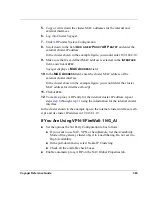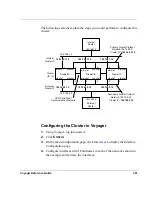
7
Configuring Traffic Management
380
Voyager Reference Guide
3.
If the nodes A and B complete the process, the node C restarts. As soon as
it does, one of the other nodes becomes the originating node and the
cluster continues to function.
!
If the node C restarts successfully, it rejoins the cluster.
!
If the node C does not restart successfully, the other two nodes
continue to function as a cluster.
Note
Your Cluster Voyager session stays active throughout the process of
rebooting the cluster. You can monitor the process by clicking
Cluster
Safe Reboot Status.
Caution
Do not log out of Cluster Voyager, end your browser session, or
otherwise break your connection with the cluster while a cluster safe
reboot is in progress. Doing so causes the nodes that you are not
logged into to leave the cluster. (If you logged into Cluster Voyager
using a cluster IP address, you are logged into the master.) If this
occurs, manually rejoin the systems to the cluster.
You can also reboot all the cluster nodes simultaneously. In this case, your
Cluster Voyager session does not stay active throughout the reboot process.
To reboot all the nodes simultaneously:
1.
On the main configuration page in Cluster Voyager, click
Reboot, Shut
Down System
.
2.
Click
R
EBOOT
(do not click
Cluster Traffic Safe Reboot
).
Summary of Contents for Network Voyager
Page 1: ...Voyager Reference Guide Part No N450820002 Rev A Published December 2003 ...
Page 4: ...4 Voyager Reference Guide ...
Page 30: ...2 How to Use Voyager 30 Voyager Reference Guide ...
Page 32: ...3 Command Line Utility Files 32 Voyager Reference Guide ...
Page 220: ...5 Configuring Interfaces 220 Voyager Reference Guide ...
Page 446: ...7 Configuring Traffic Management 448 Voyager Reference Guide ...
Page 618: ...10 Configuring Security and Access 620 Voyager Reference Guide ...
Page 668: ...14 Configuring IPv6 670 Voyager Reference Guide ...
Page 672: ...15 IPSO Process Management 674 Voyager Reference Guide ...
Page 700: ...Index 702 Voyager Reference Guide ...
















































